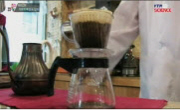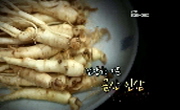인삼은 대부분 홍삼으로 1차 가공되며 농축액, 캡슐, 분말 등의 2차 가공품으로 소비된다. 수삼은 홍삼 대비 다양하지 못한 제품 형태와 쓴맛으로 인해 소비에 한계가 있다. 따라서, 본 연구...
http://chineseinput.net/에서 pinyin(병음)방식으로 중국어를 변환할 수 있습니다.
변환된 중국어를 복사하여 사용하시면 됩니다.
- 中文 을 입력하시려면 zhongwen을 입력하시고 space를누르시면됩니다.
- 北京 을 입력하시려면 beijing을 입력하시고 space를 누르시면 됩니다.
로스팅 인삼 분말을 이용한 커피 및 차류 제품 개발 연구 = A study on coffee and tea product development using roasted ginseng powder
한글로보기https://www.riss.kr/link?id=T15999834
- 저자
-
발행사항
포천 : 차의과학대학교 일반대학원, 2021
-
학위논문사항
학위논문(석사) -- 차의과학대학교 일반대학원 , 생명과학과 식품생명공학 , 2021. 8
-
발행연도
2021
-
작성언어
영어
- 주제어
-
발행국(도시)
경기도
-
형태사항
; 26 cm
-
일반주기명
지도교수: 조형용
-
UCI식별코드
I804:41065-200000498677
- 소장기관
-
0
상세조회 -
0
다운로드
부가정보
국문 초록 (Abstract)
인삼은 대부분 홍삼으로 1차 가공되며 농축액, 캡슐, 분말 등의 2차 가공품으로 소비된다. 수삼은 홍삼 대비 다양하지 못한 제품 형태와 쓴맛으로 인해 소비에 한계가 있다. 따라서, 본 연구의 목적은 인삼의 활용도 증진을 위해 맞춤형 가공기술 및 이를 활용한 일반 식품을 개발하여 상업적으로 활용할 수 있도록 수삼의 건조, 로스팅, 분말화, 그리고 제품개발의 연구를 수행하였다. 수삼을 열풍과 과열수증기를 이용한 건조를 하여 이의 특성을 평가, 건삼을 유동층 impingement 열풍 로스팅하여 물리화학적, 형태학적 특성에 미치는 영향을 연구하여 산업화 가능성을 타진하였다. 건삼과 로스팅 처리된 인삼은 조분쇄와 저온초미쇄분쇄를 통해 분말화되었으며 이의 물리화학적, 흐름성, 인스턴트 특성, 그리고 관능특성을 평가하였다. 인삼 농축액을 활용한 인삼 콜드브루 커피와 최종 로스팅 처리된 인삼 분말들을 활용한 인삼 캡슐커피와 차를 개발하여 이의 이화학적, 관능특성, 그리고 소비자 기호도를 평가하였다. 연구 결과, 과열수증기의 열전달 속도가 열풍보다 빠르기에 과열수증기를 처리한 인삼의 건조 속도가 더 빠를 것이라는 가설을 증명하지 못하였는데, 이는 본 연구에 사용된 건조 장비에서 두 가지 열 매개체가 동등한 유량과 속도 조건 설정이 불가능하였기 때문이다. 하지만, 과열증기를 처리한 인삼의 표면 구조가 더 매끈하였으며 더 노르스름한 색을 띤 것을 확인하였다. 로스팅 처리된 인삼은 건삼보다 부피가 팽창하였으며 기공 구조의 형성으로 인한 추출 수율과 산성다당체 함량, terpene류 향기 성분 증가, 그리고 구수한 향미를 나타내는 pyrazine 화합물이 생성되었다. 초미쇄분말은 조분쇄분말과 비교한 결과, 열변성 없이 10 ㎛의 입자크기와 구형의 입자 형태를 가지며 벌크밀도, 탭밀도 그리고 흐름성이 감소하였으며 습윤성, 용해성, 분산성, 입안에서의 느낌이 증가 되었다. 로스팅 처리된 분말은 건삼 분말보다 인삼 향미와 전반적인 기호도가 증가 되었으며 이를 제품개발에 활용하고자 하였다. 인삼 농축액을 활용한 콜드 브루 커피와 로스팅 인삼 분말을 활용한 인삼 캡슐커피의 소비자 기호도 평가 결과 전반적인 기호도가 각각 5점 척도 중 4.0 (약간좋다), 7점 척도 중 5.0 (약간좋다) 이었다. 4가지 인삼 분말을 활용한 인삼 캡슐차의 관능평가 결과, 로스팅 분말을 활용한 차의 모든 관능특성이 건삼보다 우수하였다.
위의 결과를 종합하여 볼 때, 유동층 impingement 로스팅은 추출 수율과 기호성을 증대시킬 수 있는 가공기술이며 분말화를 통해 분말 원료를 확보하여 일반 식품으로서 기호성과 음용하기 간편한 커피와 차의 개발이 가능함을 확인하였다.
다국어 초록 (Multilingual Abstract)
The purpose of this study is to investigate the impingement drying characteristics of fresh ginseng and physicochemical and sensory evaluation of ginseng powder treated with roasting, and to develop ginseng product for convenient coffee and tea with r...
The purpose of this study is to investigate the impingement drying characteristics of fresh ginseng and physicochemical and sensory evaluation of ginseng powder treated with roasting, and to develop ginseng product for convenient coffee and tea with roasted ginseng powder. Chapter Ⅲ was investigated the temperature profile, moisture contents, color and microstructure of ginseng dried by hot air (HA) and superheated steam (SHS). Impingement drying experiments were conducted on raw ginseng cubes, using HA and SHS at 140, 160 and 180℃. Drying rates of ginseng dried by SHS were lower than those dried by HA and the higher temperature, the shorter the drying time. Ginseng dried by SHS was more glossy and dense, because no granule remain on the surface, and more redness. The objective of Chapter Ⅳ was to investigate the effect of roasting and superfine grinding technology on the physical properties and sensory properties of ginseng. The bulk density, expansion volume, SEM image, extraction yield, flavor compounds and acidic polysaccharide of dried and roasted ginseng were investigated. And the particle size distribution, SEM image, color, ginsenoside, flowability, instant properties and sensory evaluation of ginseng powder were investigated. Roasted ginseng increased extraction yield and acidic polysaccharide, and detected pyrazine compound. Volume of roasted ginseng was expanded about 1.23 times. Compared with coarse particles, the superfine particles of ginseng powder were decreased bulk density, tapped density and flowability, whereas wettability, dispersibility, solubility and mouthfeel were increased. Roasted ginseng powder received the higher preference scores in ginseng aroma, taste and overall acceptance. Chapter Ⅴ was investigated to develop ginseng coffee and tea for convenient ginseng product with roasted ginseng. Physicochemical properties and sensory evaluation of ginseng coffee and tea were evaluated. Roasted ginseng coffee and tea received the higher preference scores in all sensory properties. Through this study, roasted ginseng powder will be applied to food materials such as food flavoring, to contribute to the enhancement of the usage of ginseng.
목차 (Table of Contents)
- Ⅰ. INTRODUCTION 1
- Ⅱ. LITERATURE REVIEW 5
- 1. Ginseng 5
- 2. Impingement Drying 8
- 3. Roasting 11
- Ⅰ. INTRODUCTION 1
- Ⅱ. LITERATURE REVIEW 5
- 1. Ginseng 5
- 2. Impingement Drying 8
- 3. Roasting 11
- 4. Grinding 13
- 5. Powder Properties 15
- Ⅲ. Impingement Drying of Raw Ginseng Cubes in Hot Air and Superheated Steam 17
- 1. Abstract 17
- 2. Materials and Methods 18
- A. Raw Materials 18
- B. Experimental Set-up 18
- C. Drying Procedure 21
- D. Moisture Contents 21
- E. Color 22
- F. Scanning Electron Microscopy (SEM) 22
- 3. Results and Discussion 23
- A. Moisture Contents 23
- B. Appearance and Color 26
- C. Scanning Electron Microscopy (SEM) 31
- 4. Conclusion 33
- Ⅳ. Effects of Roasting and Superfine Grinding on Physicochemical and Sensory Characteristics of Ginseng and its Powder 34
- 1. Abstract 34
- 2. Materials and Methods 36
- A. Ginseng Preparation and Pre-treatment 36
- B. Preparation of Ginseng Powder 36
- C. Chemicals 39
- D. Physicochemical Properties of Ginseng Grits 39
- (1) Moisture content, Density and Expansion Volume 39
- (2) Scanning Electron Microscopy (SEM) 40
- (3) Extraction Yield 41
- (4) Acidic Polysaccharide Content 41
- (5) Flavor Compound 42
- E. Physicochemical Properties of Ginseng Powder 44
- (1) Color 44
- (2) Scanning Electron Microscopy (SEM) 44
- (3) Particle Size Distribution 44
- (4) Ginsenoside Content 45
- F. Flow Properties of Ginseng Powder 46
- (1) Bulk Density and Tapped Density 46
- (2) Flowability and Cohesiveness 46
- (3) Angle of Repose 47
- G. Instant Properties of Ginseng Powder 47
- (1) Wettability 47
- (2) Dispersibility 48
- (3) Water Solubility Index (WSI) 48
- H. Sensory Evaluation 48
- I. Statistical Analysis 49
- 3. Results and Discussion 50
- A. Physicochemical Properties of Ginseng Grits 50
- (1) Appearance, Moisture content, Density and Expansion Volume 50
- (2) Scanning Electron Microscopy (SEM) 53
- (3) Extraction Yield 55
- (4) Acidic Polysaccharide Content 55
- (5) Flavor Compound 58
- B. Physicochemical Properties of Ginseng Powder 65
- (1) Appearance and Color 65
- (2) Scanning Electron Microscopy (SEM) 65
- (3) Particle Size Distribution 69
- (4) Ginsenoside Content 73
- C. Flow Properties of Ginseng Powder 76
- D. Instant Properties of Ginseng Powder 79
- E. Sensory Evaluation 82
- 4. Conclusion 84
- Ⅴ. Development of Ginseng Coffee and Tea from Ginseng Extracts and Roasted Ginseng Powder 85
- 1. Abstract 85
- 2. Materials and Methods 86
- A. Materials 86
- B. Ginseng coffee and Tea Preparation 86
- (1) Ginseng Cold Brew Stick coffee 86
- (2) Single-serve Ginseng Capsule Coffee 87
- (3) Single-serve Ginseng Capsule Tea 87
- C. Physicochemical Properties 88
- (1) Total Dissolved Solid 88
- (2) pH 88
- (3) °Brix 89
- (4) Titratable acidity 89
- (5) Color 89
- D. Sensory Evaluation 90
- (1) Ginseng Cold Brew Stick coffee 90
- (2) Single-serve Ginseng Capsule Coffee 90
- (3) Single-serve Ginseng Capsule Tea 91
- E. Statistical Analysis 91
- 3. Results and Discussion 92
- A. Physicochemical Properties 92
- (1) Ginseng Cold Brew Stick coffee 92
- (2) Single-serve Ginseng Capsule Coffee 94
- (3) Single-serve Ginseng Capsule Tea 98
- B. Sensory Evaluation 101
- (1) Ginseng Cold Brew Stick coffee 101
- (2) Single-serve Ginseng Capsule Coffee 103
- (3) Single-serve Ginseng Capsule Tea 106
- 4. Conclusion 108
- REFERENCES 110
- ABSTRACT IN KOREAN 133












